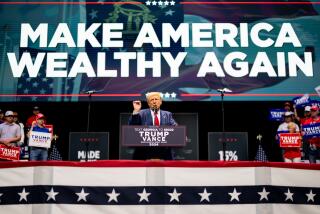Economic growth stumbled in fourth quarter, closing the weakest year for U.S. since 2011
- Share via
Reporting from Washington — The U.S. economy stumbled in the fourth quarter, expanding at a disappointing 1.9% annual pace and making last year the weakest for growth since 2011, the Commerce Department reported Friday.
The figure for the October-through-December period was below analyst expectations and well off the 3.5% annual growth rate for the third quarter. That was the strongest pace in two years.
But a sharp reversal in exports — down 4.3% after a 10% increase in the previous quarter — and slower pace of consumer spending growth in the fourth quarter offset an improvement in business investment.
Economists expected growth to decline after a jump in the third quarter that was fueled by consumers and businesses making up for a dismal first half of the year. The economy expanded at just a 0.8% rate in the first quarter of 2016 and 1.4% in the second quarter.
The report showed how difficult President Trump’s vow of 4% annual growth will be to achieve.
“I almost want to say 4% is out of reach. It’s a huge stretch,” said Scott Anderson, chief economist at Bank of the West.
He noted the economy is close to full employment and global growth is weak, reducing demand for U.S. exports.
He’s forecasting 2.2% annual growth this year and 2.8% next year, anticipating that tax cuts being pushed by Trump and congressional Republicans won’t happen until at least the fall.
Although the fourth-quarter figure was below expectations, the 1.9% annual growth rate was decent compared to earlier in 2016, economists said.
“Even though overall growth slowed, the underlying economic strength was solid during the final quarter of 2016,” said Sung Won Sohn, an economist at Cal State Channel Islands.
Anderson noted that economic growth averaged a 2.7% annual rate in the second half of the year, a marked improvement from the first half’s 1.1% growth pace.
“It shows the U.S. economy expansion has some momentum going into the first quarter of this year,” said Anderson.
Companies continued to expand their inventories in the fourth quarter as consumer and business confidence picked up.
Inventory growth added 1 percentage point to overall economic output, the second-straight quarter of a positive contribution after five quarters in which inventory declines subtracted from growth.
More broadly, private investment increased 10.7% in the fourth quarter after a 3% increase the previous quarter.
The growth in consumer spending slowed to 2.5% in the fourth quarter from 3% the previous quarter. Still, economists said that was a solid pace.
But exports were a major drag as the strong dollar and economic troubles abroad reduced demand for U.S. products. The pace of export growth declined for the fourth time in the past six quarters.
The overall fourth-quarter data, the first of three official estimates, mean that the U.S. economy expanded just 1.6% for all of 2016. That was down from 2.6% the previous year and the worst performance since 2011.
The figures also cement Obama’s status as the first president since Herbert Hoover to not have at least one year of economic growth at 3% or higher.
The best year under Obama was 2015, when the economy expanded 2.6%.
But economists note that Obama started his term in the depths of the Great Recession, which began in late 2007. The economy contracted 2.8% in his first year in office. Growth returned in 2010 but has been around 2% since then.
Trump has promised that his policies will boost growth.
“To get the economy back on track, President Trump has outlined a bold plan to create 25 million new American jobs in the next decade and return to 4 percent annual economic growth,” according to the “Bringing Back Jobs and Growth” page on the White House website.
That would be accomplished by lower taxes, including cutting the corporate rate, eliminating “job-killing regulations” and striking new trade deals that lead to more manufacturing jobs in the U.S., the White House said.
But Steven Mnuchin, Trump’s nominee for Treasury secretary, appeared to scale down expectations during his confirmation hearing last week, saying his main objective was annual growth of 3% to 4%.
Follow @JimPuzzanghera on Twitter
MORE BUSINESS NEWS
The U.S. labor force’s guy problem: Lots of men don’t have a job and aren’t looking for one
How Trump could use the presidency to help his own business interests
Surge in media mergers is expected under Trump’s pro-business agenda
UPDATES:
9:05 a.m.: This article was updated with additional details from the report as well as comments from economists Scott Anderson of the Bank of the West and Sung Won Sohn of Cal State Channel Islands.
This article originally was published at 6:25 a.m.
More to Read
Inside the business of entertainment
The Wide Shot brings you news, analysis and insights on everything from streaming wars to production — and what it all means for the future.
You may occasionally receive promotional content from the Los Angeles Times.











